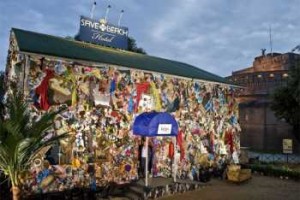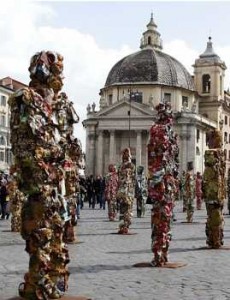Rome is home to the Pantheon and the Colosseum, but last week the city added something entirely different—and trashier—to its architectural repertoire.

The Save the Beach hotel is made from twelve tons of trash
A temporary hotel, built almost exclusively from trash collected on Italian beaches, was open for business June 3-7. German artist HA Schult told The Times Online that he built the hotel as a “mirror of our time.” He sees his work as a call to action, and said, “We must change the world before the world changes us.”
Schult’s “Trash People” installation has been on display at several international landmarks, but this is his first trash building. The project was sponsored by Corona’s Save The Beach campaign, which asks Corona customers to nominate and vote on European beaches to be salvaged. It plans to recover at least one beach annually.
The hotel, which was built in the gardens of the Castel Sant’Angelo and just across the Tiber River from Vatican City, is composed of twelve tons of collected garbage, such as plastic bags, beer cans, discarded cameras, and lost clothing.
Guests included winners of a Corona contest, Danish supermodel and environmentalist Helena Christensen, and others who booked their stays far in advance of the June 3 premiere.
Christensen is a spokesperson for the Save The Beach campaign.
“I am deeply disturbed by the state of our beaches,” she said in an interview with The Times Online. She said she had “a great night” in the hotel, and commented in a BBC News report that her experience made her “really wonder what made a human being throw away (these objects) on a beach.”

HA Schult's 1,000 "Trash People" have traveled the world to raise awareness of environmental issues
“You walk down the beach and you realize how incredibly ignorant we are with garbage,” she said in an interview with Agence France-Presse (AFP).
Schult and company are not the first to dabble in residential recycling, however. In 2008, German artists Folke Koebberling and Martin Kaltwasser built the Cambridgeshire, England Fenland pavilion from waste and unwanted doors and windows.
“With their approach, that same ‘waste’ often going to costly landfill can be rebuilt—recycled, reused, and recreated to make something not only beautiful but functional,” Cambridgeshire’s Wysing Arts Centre director Donna Lynas told Building Design Online.
Schult’s creation is the first trash hotel, and its debut coincided with World Environment Day. “We are in the trash time,” he told AFP.
—Natalie Orenstein/Newsdesk
VIDEO: Save the Beach interview with Helena Christensen
CITATIONS:
Helena Christensen stays in trash hotel to highlight litter crisis
Times Online, June 5, 2010
Rome’s trashiest hotel built with 12 tons of litter
Treehugger, June 6, 2010
Among Rome’s ancient ruins, a hotel made entirely of trash
Fast Company, June 4, 2010
Rome gets hotel made from rubbish
BBC News, June 4, 2010
Trash-coated ‘hotel’ set up in Rome
Agence France-Presse, June 4, 2010
Cambrideshire’s trash palace
Building Design Online, September 9, 2008
Dear Ms. Orenstein,
Interesting article. It is quite amazing to see how tons of trash can be turned into a beautiful, functioning art piece/hotel. So sad to think that all of this garbage would have just floated into the sea. Thanks for helping to get the message out to the beach goers of the world. Keep up the good work.
Karen Weil